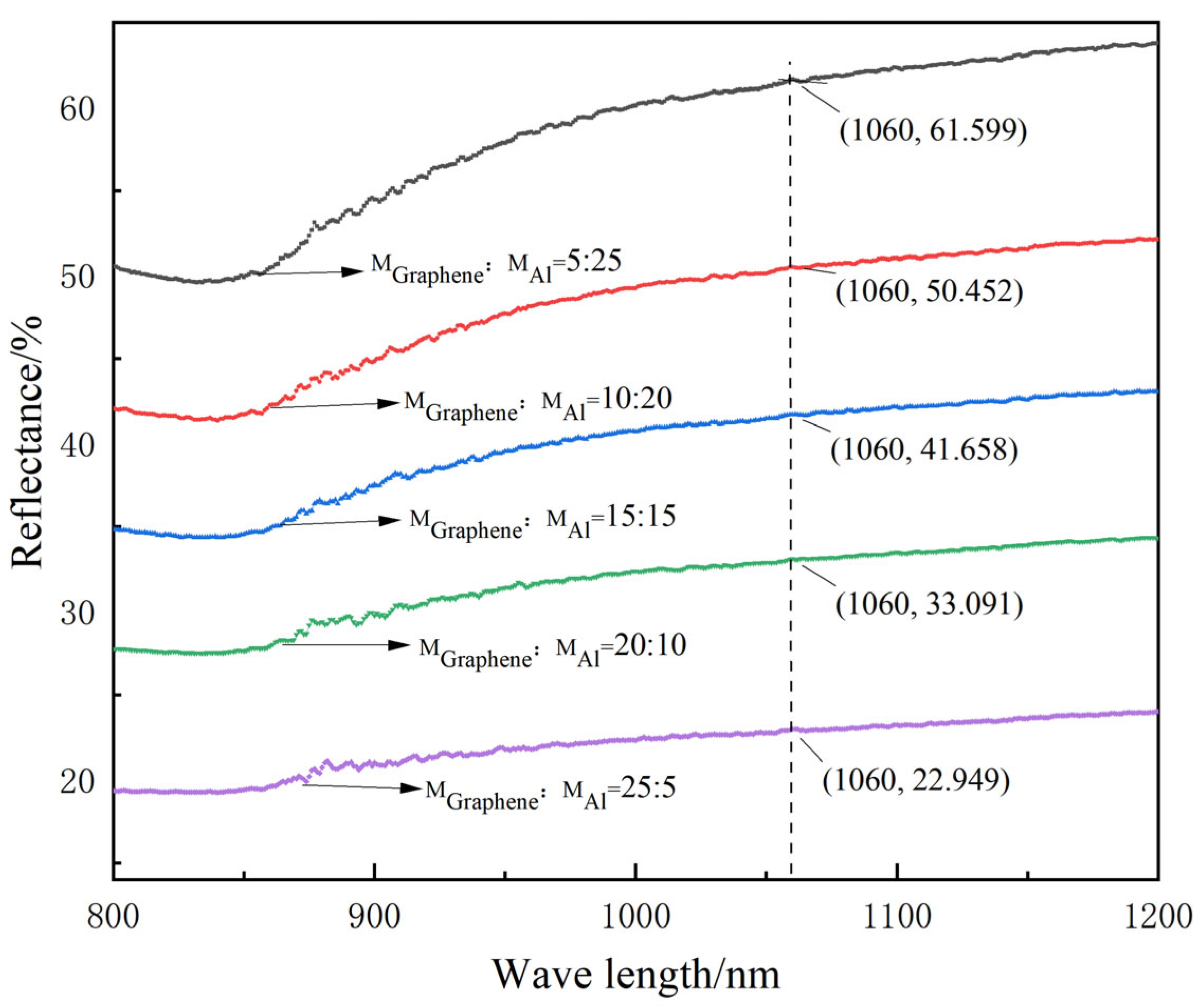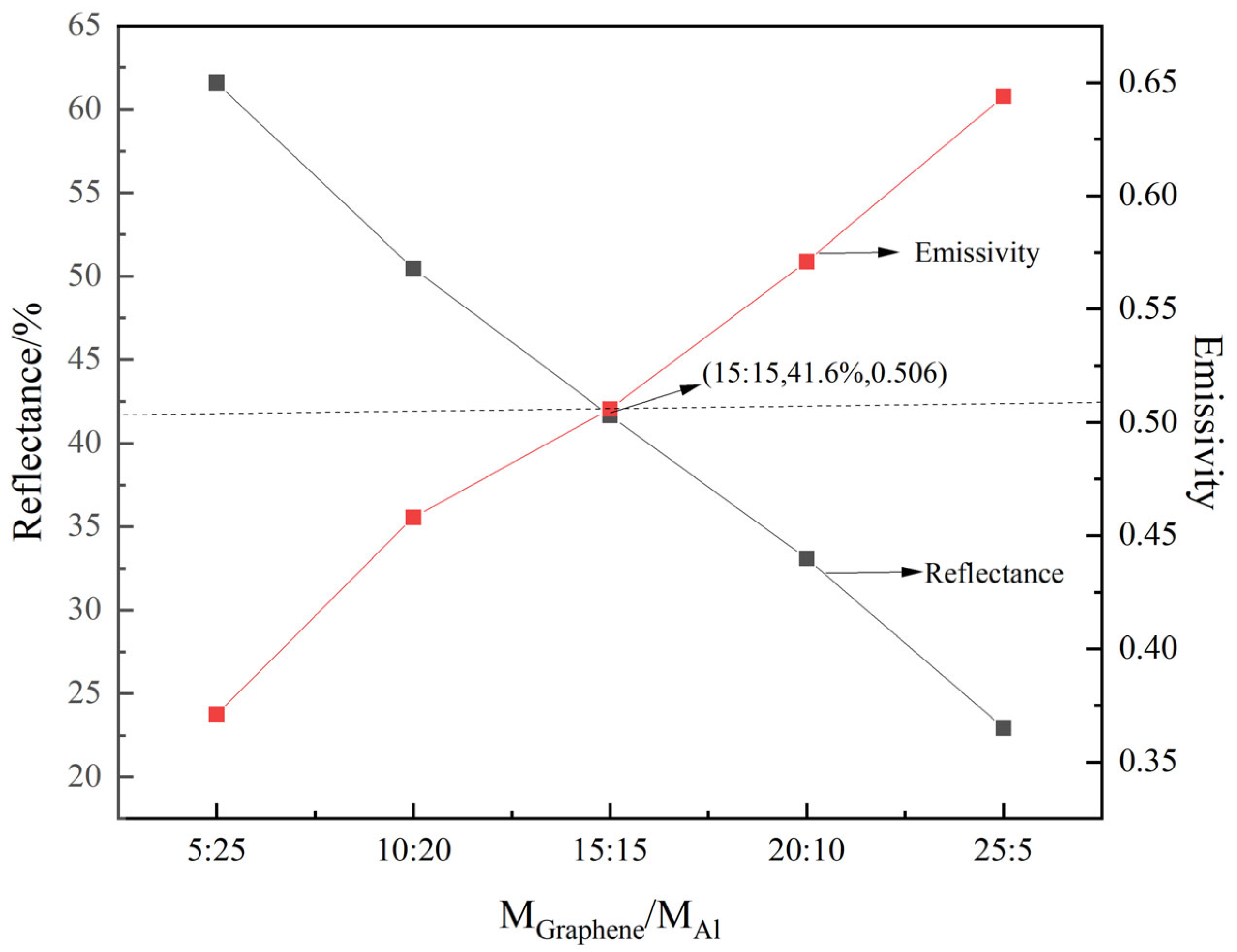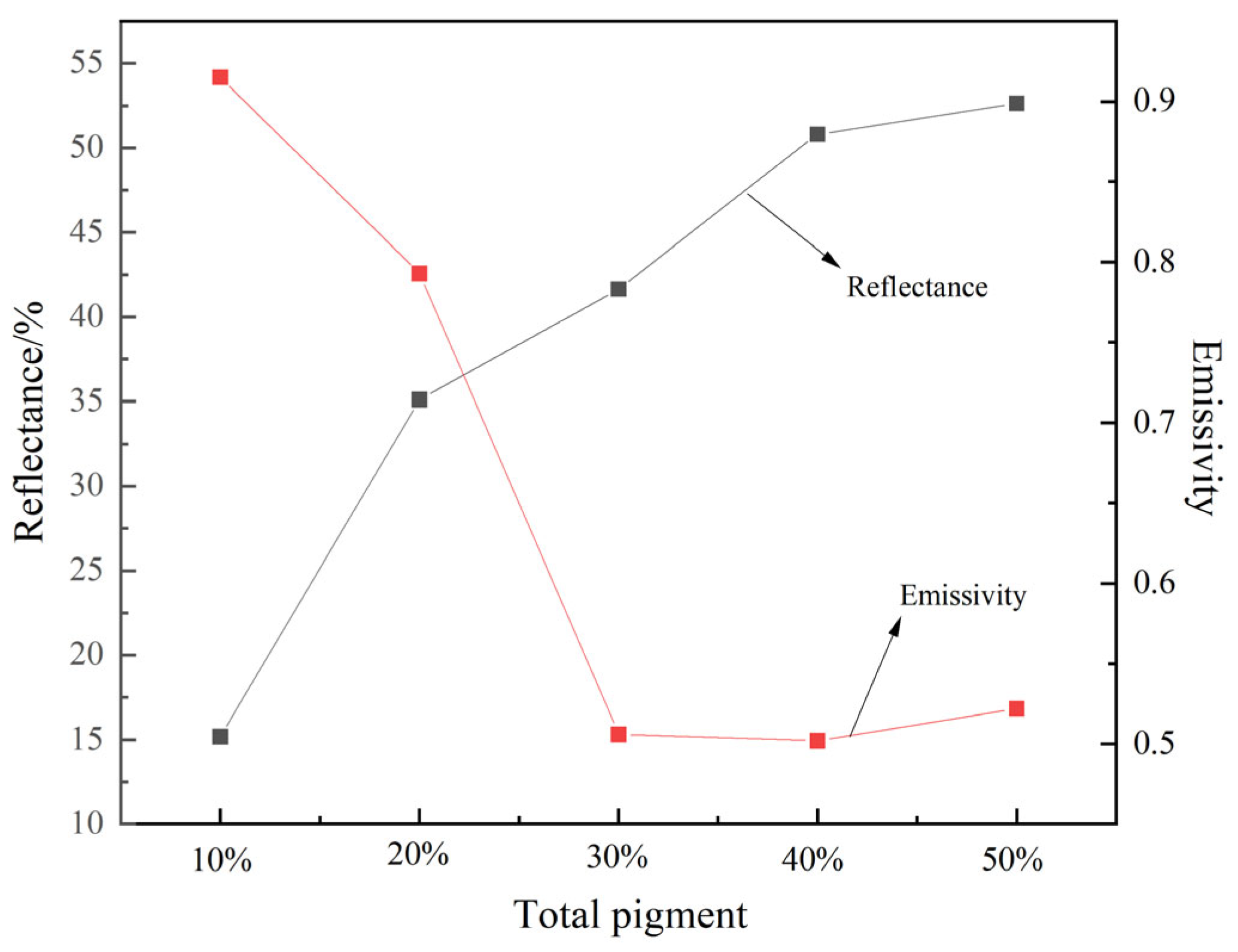Preparation and Characterization of High-Performance Composite Coatings Compatible with Near-Infrared Low Reflectivity and Low Infrared Emissivity
Abstract
:1. Introduction
2. Materials and Methods
2.1. Materials
2.2. Preparation of the Coating
2.3. Characterization
3. Results and Discussion
3.1. Effect of Different Graphene and Al Mass Ratios on Coating Performance
3.2. Effect of Different Pigment Additions on Coating Performance
4. Conclusions
Author Contributions
Funding
Institutional Review Board Statement
Informed Consent Statement
Data Availability Statement
Conflicts of Interest
References
- Zhang, Q.; Ma, Z.; Gao, L.; Zhen, Y.; Liu, L.; Liu, Y.; Xu, F. Laser stealth and laser protection properties of oxide-carbide coatings prepared by atmospheric plasma spraying. Ceram. Int. 2022, 48, 31389–31396. [Google Scholar] [CrossRef]
- Jang, B.; Kim, M.; Park, J.; Lee, S. Design Optimization of Composite Radar Absorbing Structures to Improve Stealth Performance. Int. J. Aeronaut. Space Sci. 2016, 17, 20–28. [Google Scholar] [CrossRef]
- Zhao, H.; Guo, D.; Sheng, T.; Wen, Y.; Rui, T. Infrared emissivity properties of infrared stealth coatings prepared by water-based technologies. Opt. Mater. 2016, 6, 3716–3724. [Google Scholar]
- Long, X.; Lei, X.; Du, H.; Mehmood, A.; Li, X.; Liu, X. Recent Research Progress in Electrochromic Materials for Intelligent Stealth (Visible and Infrared): A review. J. Phys. Conf. Ser. 2023, 2440, 012005. [Google Scholar] [CrossRef]
- Chang, C. Hyperspectral Anomaly Detection: A Dual Theory of Hyperspectral Target Detection. IEEE Trans. Geosci. Remote Sens. 2022, 60, 1–20. [Google Scholar] [CrossRef]
- Zhao, X.; Dai, J.; Li, L.; Su, Z.; Ma, X. Deep learning-based laser and infrared composite imaging for armor target identification and segmentation in complex battlefield environments. Infrared Phys. Technol. 2023, 132, 104725. [Google Scholar] [CrossRef]
- Zhang, Y.; Qin, Y.; Quan, B.; Shao, T.; Guo, T.; Zhang, M.; Huang, X. Simultaneous low reflection in near-infrared range and low emission in long-wave infrared properties of Al/Bi2O3 composites. Ceram. Int. 2021, 47, 1180–31186. [Google Scholar] [CrossRef]
- Hu, J.; Hu, Y.; Ye, Y.; Shen, R. Unique applications of carbon materials in infrared stealth: A review. Chem. Eng. J. 2023, 452, 139147. [Google Scholar] [CrossRef]
- Gu, J.; Wang, W.; Yu, D. Temperature control and low infrared emissivity double shell phase change microcapsules and their application in infrared stealth fabric. Prog. Org. Coat. 2021, 159, 106439. [Google Scholar] [CrossRef]
- Xu, R.; Wang, W.; Yu, D. A novel multilayer sandwich fabric-based composite material for infrared stealth and super thermal insulation protection. Compos. Struct. 2019, 212, 58–65. [Google Scholar] [CrossRef]
- Chen, L.; Ren, Z.; Liu, X.; Wang, K.; Wang, Q. Infrared-visible compatible stealth based on Al-SiO2 nanoparticle composite film. Opt. Commun. 2021, 482, 126608. [Google Scholar] [CrossRef]
- Wang, B.; Xu, G.; Song, S.; Ren, Z.; Li, X.; Li, J.; Xu, X.; Zhou, W.; Li, H.; Zhang, L.; et al. Electro-emissive device based on novel PANI/Au composite films with neoteric mosaic structure for infrared stealth and thermal radiation control. Electrochim. Acta 2021, 390, 138891. [Google Scholar] [CrossRef]
- Yan, X.; Wang, L.; Qian, X. Preparation and Characterization of Low Infrared Emissive Aluminum/Waterborne Acrylic Coatings. Coatings 2020, 10, 35. [Google Scholar] [CrossRef]
- Zhang, W.; Ma, Z.; Lv, D.; Luo, J.; Li, J. An ultra-low infrared emissivity composite coating with outstanding mechanical properties and salt water resistance. Infrared Phys. Technol. 2022, 126, 104351. [Google Scholar] [CrossRef]
- Qin, Y.; Zhang, M.; Guan, Y.; Huang, X. Laser absorption and infrared s-tealth properties of Al/ATO composites. Ceram. Int. 2019, 45, 14312–14315. [Google Scholar] [CrossRef]
- Zhu, D.; Li, K.; Luo, F.; Zhou, W. Preparation and infrared emissivity of ZnO: Al (AZO) thin films. Appl. Surf. Sci. 2009, 255, 6145–6148. [Google Scholar] [CrossRef]
- Malouf, A.; Henderson-Sapir, O.; Set, S.; Yamashita, S.; Ottaway, D. Two-photon absorption and saturable absorption of mid-IR in graphene. Appl. Phys. Lett. 2019, 114, 091111. [Google Scholar] [CrossRef]
- Cao, S.; Wang, Q.; Gao, X.; Zhang, S.; Hong, R.; Zhang, D. Monolayer graphene based tunable absorber in the near-infrared. Micromachines 2021, 12, 1320. [Google Scholar] [CrossRef] [PubMed]
- Thomas, L.; Sorathiya, V.; Patel, S.; Guo, T. Graphene-based tunable near-infrared absorber. Microw. Opt. Technol. Lett. 2019, 61, 1161–1165. [Google Scholar] [CrossRef]
- GB 1720-79(89); Method for Determination of Adhesion to Paint Film. National Standard of the People’s Republic of China. Standardization Administration of China: Beijing, China, 2021.
- GB 1731-93; Method for Determination of Flexibility of Paint Film. National Standard of the People’s Republic of China. State Technical Supervision Bureau: Beijing, China, 1993.
- GB 1732-93; Method for Impact Resistance of Paint Film. National Standard of the People’s Republic of China. State Bureau of Technical Supervision: Beijing, China, 1993.
- Wang, J.; Zhang, W.; Lv, D. A super-hydrophobic composite coating with near-infrared low reflection and low emissivity of 8–14 μm. Optik 2021, 241, 166379. [Google Scholar] [CrossRef]






| Mgraphene:MAl | 5:25 | 10:20 | 15:15 | 20:10 | 25:5 |
|---|---|---|---|---|---|
| Adhesion strength/grade | 1 | 1 | 1 | 1 | 1 |
| Flexibility/mm | 2 | 2 | 2 | 2 | 2 |
| Impact strength/kg × cm | 50 | 50 | 50 | 50 | 50 |
| Contents of Total Pigments | 10 wt% | 20 wt% | 30 wt% | 40 wt% | 50 wt% |
|---|---|---|---|---|---|
| Adhesion strength/grade | 1 | 1 | 1 | 1 | 1 |
| Flexibility/mm | 2 | 2 | 2 | 4 | 8 |
| Impact strength/kg × cm | 50 | 50 | 50 | 50 | 45 |
Disclaimer/Publisher’s Note: The statements, opinions and data contained in all publications are solely those of the individual author(s) and contributor(s) and not of MDPI and/or the editor(s). MDPI and/or the editor(s) disclaim responsibility for any injury to people or property resulting from any ideas, methods, instructions or products referred to in the content. |
© 2023 by the authors. Licensee MDPI, Basel, Switzerland. This article is an open access article distributed under the terms and conditions of the Creative Commons Attribution (CC BY) license (https://creativecommons.org/licenses/by/4.0/).
Share and Cite
Zhuang, Y.; Zhang, W.; Zhang, Q. Preparation and Characterization of High-Performance Composite Coatings Compatible with Near-Infrared Low Reflectivity and Low Infrared Emissivity. Coatings 2023, 13, 2033. https://doi.org/10.3390/coatings13122033
Zhuang Y, Zhang W, Zhang Q. Preparation and Characterization of High-Performance Composite Coatings Compatible with Near-Infrared Low Reflectivity and Low Infrared Emissivity. Coatings. 2023; 13(12):2033. https://doi.org/10.3390/coatings13122033
Chicago/Turabian StyleZhuang, Yueting, Weigang Zhang, and Qianfeng Zhang. 2023. "Preparation and Characterization of High-Performance Composite Coatings Compatible with Near-Infrared Low Reflectivity and Low Infrared Emissivity" Coatings 13, no. 12: 2033. https://doi.org/10.3390/coatings13122033
APA StyleZhuang, Y., Zhang, W., & Zhang, Q. (2023). Preparation and Characterization of High-Performance Composite Coatings Compatible with Near-Infrared Low Reflectivity and Low Infrared Emissivity. Coatings, 13(12), 2033. https://doi.org/10.3390/coatings13122033





